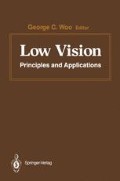Abstract
The defining property of retinal X-like cells and cortical simple cells is that they exhibit a null phaseat which grating stimuli produce little or no response [1–5]. It follows that for such “linear summation”cells a masking stimulus at the null phase should have no effect on detection of a stimulus at the optimum phase (90 degrees from the null phase). When the stimuli are in phase, however, we expect the masking stimulus to reduce sensitivity according to the power law of the contrast discrimination function [6]. Thus, if the contrast transducer function were determined exclusively by either retinal X-like cells or cortical simple cells, the degree of masking should be markedly affected by the phase of the background relative to the test.
Access this chapter
Tax calculation will be finalised at checkout
Purchases are for personal use only
Preview
Unable to display preview. Download preview PDF.
References
D.H. Hubel, T.N. Wiesel: Laminar and columnar distribution of geniculo-cortical fibers in the macaque monkey. J. Comp. Neurol. 146, 421 (1972)
C. Enroth-Cugell, J.G. Robson: The contrast sensitivity of retinal ganglion cells of the cat. J. Physiol: (Lond.) 187, 517 (1966)
P.H. Schiller, J.G. Malpeli: Functional specificity of lateral geniculate nucleus laminae of the rhesus monkey. J. Neurophysiol. 41, 788 (1978)
D.H. Hubel, T.N. Wiesel: Receptive fields, binocular interaction, and functional architecture in the cat’s visual cortex. J. Physiol. (Lond.) 160, 106 (1962)
E. Kaplan, R.M. Shapley: X and Y cells in the lateral geniculate nucleus of macaque monkeys. J. Physiol. (Lond.) 330, 125 (1982)
G.E. Legge: A power law for contrast discrimination. Vision Res. 21, 457 (1981)
The Framingham Eye Study Monograph. Surv. Ophthalmol. (Suppl.) 24, 335 (1980)
J. Sjostrand, L. Frisen: Contrast sensitivity in macular disease. Acta Ophthalmol. (Copenh.) 55, 507 (1977)
B. Brown: Reading performance in low vision patients: Relation to contrast and contrast sensitivity. Am. J. Optom. Physiol. Opt. 58, 218 (1981)
G.S. Rubin, G.E. Legge: Predicting low-vision reading rates from measures of contrast sensitivity. Presented to the First meeting of Noninvasive Assessment of the Visual System sponsored by the Optical Society of America, Incline Village, Nevada (1985)
M. Wolkstein, A. Atkin, I. Bodis-Wollner: Contrast sensitivity in retinal disease. Ophthalmology (Rochester) 87, 1140 (1980)
R.F. Hess, R.J. Jacobs, A. Vingrys: Central versus peripheral vision: Evaluation of the residual function resulting from a uniocular macular scotoma. Am. J. Optom. Physiol. Opt. 55, 610 (1978)
D.S. Loshin, J. White: Contrast sensitivity: The visual rehabilitation of the patient with macular degeneration. Arch. Ophthalmol. 102, 1303 (1984)
R.C. Watzke: Acquired macular disease. In Clinical Ophthalmology, Vol. 3, Chapt. 23, ed. by T.D. Duane and E.A. Jaegar (Harper and Row, Philadelphia 1976)
A.M. Fine, M.J. Elman, J.E. Ebert, P.A. Prestia, J.S. Starr, S.L. Fine: Earliest symptoms caused by neovas- cular membranes in the macula. Arch. Ophthalmol. 104, 513 (1986)
G.E. Legge, D. Kersten: Contrast discrimination in peripheral vision. Invest. Ophthalmol. Vis. Sci. (Suppl.) 27, 225 (1986)
J. Rovamo, V. Virsu, R. Nasaren: Cortical magnification factor predicts the photopic contrast sensitivity of peripheral vision. Nature 271, 54 (1978)
R.F. Hess, J.S. Pointer: Differences in the neural basis of human amblyopia: The distribution of the anomaly across the visual field. Vision Res. 25, 1577 (1985)
E. Peli, T. Peli: Image enhancement for the visually impaired. Opt. Eng. 23, 47 (1984)
R.L. De Valois: Encoding of spatial frequency, orientation, and contrast in striate cortex. Optic News 11, 119 (1985) and personal communication at ARVO (1986)
J. Rovamo, V. Virsu: An estimation and application of the human cortical and magnification factor. Exp. Brain Res. 37, 495 (1979)
G. Westheimer: Scaling of visual acuity measurements. Arch. Ophthalmol. 97, 327 (1979)
C.W. Tyler: Space-time metric of function organization in human peripheral vision. Optic News 11, 113 (1985)
G.E. Legge, D.C. Pelli, G.S. Rubin, M. Schleske: Psychophysics of reading n. Low vision. Vision Res. 25, 253 (1985)
G.L. Goodrich, E.B. Mehr: Eccentric viewing training and low vision aids: Current practice and implications of peripheral retinal research. Am. J. Optom. Physiol. Opt. 63, 119 (1986)
D.B. Gennery: Determination of optical transfer function by inspection of frequency-domain plot. J. Opt. Soc. Am. 63, 1571 (1973)
T.B. Lawton: The effect of phase structure on spatial phase discrimination. Vision Res. 24, 139 (1984)
T.B. Lawton: Spatial frequency spectrum of patterns changes the visibility of spatial-phase differences. J. Opt. Soc. Am. (A) 2, 1140 (1985)
G.B. Wetherill, H. Levitt: Sequential estimation of points on a psychometric function. Br. J. Math. Stat. Psychol. 18, 1 (1965)
K.E. Higgins, M.J. Jaffe, N.J. Coletta, R.C. Caruso, F.M. de Monasterio: Spatial contrast sensitivity: Importance of controlling the patient’s visibility criterion. Arch. Ophthalmol. 102, 1035 (1984)
Y.L. Yap, H.E. Bedell, P.L. Abplanalp: Blind spot “fixation” in normal eyes: Implications for eccentric viewing in bilateral macular disease. Am. J. Optom. Physiol. Opt. 63, 259 (1986)
T.B. Lawton, C.W. Tyler: The role of X and Simple cells in the contrast transducer function. Invest. Ophthalmol. Vis. Sci. (Suppl.) 27, 340 (1986)
Editor information
Editors and Affiliations
Rights and permissions
Copyright information
© 1987 Springer-Verlag New York Inc.
About this paper
Cite this paper
Lawton, T.B. (1987). The Role of X and Simple Cells in the Contrast Transducer Function of Low Vision and Normal Observers. In: Woo, G.C. (eds) Low Vision. Springer, New York, NY. https://doi.org/10.1007/978-1-4612-4780-7_9
Download citation
DOI: https://doi.org/10.1007/978-1-4612-4780-7_9
Publisher Name: Springer, New York, NY
Print ISBN: 978-1-4612-9152-7
Online ISBN: 978-1-4612-4780-7
eBook Packages: Springer Book Archive

